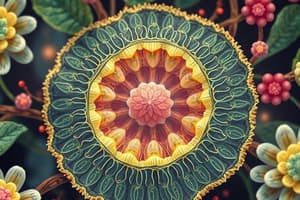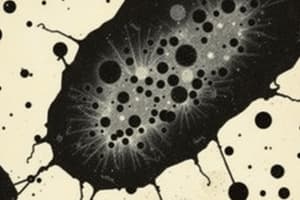Podcast
Questions and Answers
Which of the following components composes the middle lamella?
Which of the following components composes the middle lamella?
- cellulose
- suberin
- lignin
- pectin (correct)
What is the primary function of the secondary cell wall?
What is the primary function of the secondary cell wall?
- To initiate cell growth
- Support and protection for the cell (correct)
- To regulate water transport
- Cell division
When is the secondary cell wall typically formed?
When is the secondary cell wall typically formed?
- After cell division (correct)
- During active cell growth
- Before cell division
- During cell division
Why are secondary cell walls described as 'thicker'?
Why are secondary cell walls described as 'thicker'?
What is the key factor in plant developmental patterns?
What is the key factor in plant developmental patterns?
What did Schleiden and Schwann state in their cell theory, according to the provided content?
What did Schleiden and Schwann state in their cell theory, according to the provided content?
Based on the provided information, what characteristic distinguishes prokaryotic cells from other cell types?
Based on the provided information, what characteristic distinguishes prokaryotic cells from other cell types?
What does the term 'cells,' as used in the context of the provided text, refer to?
What does the term 'cells,' as used in the context of the provided text, refer to?
Based on the provided information, how did the discovery of cells impact the understanding of life?
Based on the provided information, how did the discovery of cells impact the understanding of life?
What is the main purpose of the text provided?
What is the main purpose of the text provided?
What is the primary component of cell membranes?
What is the primary component of cell membranes?
What is the main function of cell membranes?
What is the main function of cell membranes?
Which of the following is NOT a function of cell membranes?
Which of the following is NOT a function of cell membranes?
What is the role of proteins in cell membranes?
What is the role of proteins in cell membranes?
Which of the following statements accurately describes cell membranes?
Which of the following statements accurately describes cell membranes?
Which of the following is NOT a characteristic of lipids?
Which of the following is NOT a characteristic of lipids?
What property of phospholipids allows them to form cell membranes?
What property of phospholipids allows them to form cell membranes?
What is the function of cholesterol in cell membranes?
What is the function of cholesterol in cell membranes?
Which of the following statements accurately describes the amphiphilic nature of phospholipids?
Which of the following statements accurately describes the amphiphilic nature of phospholipids?
What is the main difference between phospholipids and sterols?
What is the main difference between phospholipids and sterols?
According to the provided content, what facilitates the diffusion of solutes through membranes?
According to the provided content, what facilitates the diffusion of solutes through membranes?
What is a key characteristic of membranes in the context of cell growth?
What is a key characteristic of membranes in the context of cell growth?
Based on the text, what is a primary component of membranes?
Based on the text, what is a primary component of membranes?
What is the role of 'facilitators' in the context of membrane transport?
What is the role of 'facilitators' in the context of membrane transport?
What can be inferred about membranes based on the information provided?
What can be inferred about membranes based on the information provided?
What is the primary function of the cytoplasm's matrix, known as the cytosol?
What is the primary function of the cytoplasm's matrix, known as the cytosol?
What is the role of intrinsic proteins in the transport of vital substances?
What is the role of intrinsic proteins in the transport of vital substances?
Which of the following is NOT a characteristic of cytosol?
Which of the following is NOT a characteristic of cytosol?
What is the significance of metabolic reactions occurring in the cytosol?
What is the significance of metabolic reactions occurring in the cytosol?
Which statement accurately describes the relationship between intrinsic proteins and transport of vital substances?
Which statement accurately describes the relationship between intrinsic proteins and transport of vital substances?
Flashcards
Microscope
Microscope
An instrument used to see small objects including cells.
Cells
Cells
Basic building blocks of all living organisms identified by early biologists.
Prokaryotic Cells
Prokaryotic Cells
Simple cells without a nucleus, like bacteria.
Cell Theory
Cell Theory
Signup and view all the flashcards
Biologists
Biologists
Signup and view all the flashcards
Middle Lamella
Middle Lamella
Signup and view all the flashcards
Pectin
Pectin
Signup and view all the flashcards
Secondary Cell Wall
Secondary Cell Wall
Signup and view all the flashcards
Cell Enlargement
Cell Enlargement
Signup and view all the flashcards
Cell Division
Cell Division
Signup and view all the flashcards
Membrane Formation
Membrane Formation
Signup and view all the flashcards
Facilitators
Facilitators
Signup and view all the flashcards
Diffusion
Diffusion
Signup and view all the flashcards
Solutes
Solutes
Signup and view all the flashcards
Lipid Molecules
Lipid Molecules
Signup and view all the flashcards
Types of Lipids
Types of Lipids
Signup and view all the flashcards
Phospholipids
Phospholipids
Signup and view all the flashcards
Sterols
Sterols
Signup and view all the flashcards
Amphiphilic Property
Amphiphilic Property
Signup and view all the flashcards
Membrane Composition
Membrane Composition
Signup and view all the flashcards
Plant Cell
Plant Cell
Signup and view all the flashcards
Cell Membrane
Cell Membrane
Signup and view all the flashcards
Composition of Cell Membrane
Composition of Cell Membrane
Signup and view all the flashcards
Functions of Membrane
Functions of Membrane
Signup and view all the flashcards
Lipids
Lipids
Signup and view all the flashcards
Transport of vital substances
Transport of vital substances
Signup and view all the flashcards
Cytosol
Cytosol
Signup and view all the flashcards
Intrinsic proteins
Intrinsic proteins
Signup and view all the flashcards
Metabolic reactions
Metabolic reactions
Signup and view all the flashcards
Organelles
Organelles
Signup and view all the flashcards
Study Notes
Plant Cell Structure
- Plant cells are composed of protoplasm and a cell membrane
- Biologists identify two main cell types: prokaryotic and eukaryotic.
- Prokaryotic cells lack a nucleus and are simple, found in single-celled organisms and bacteria.
- Eukaryotic cells have a nucleus and are found in complex organisms like plants, animals, fungi, and algae.
- Plant cells, being eukaryotic, contain a nucleus and other membrane-bound organelles.
Plant Cell Components
- The plant cell is surrounded by a rigid cell wall composed of cellulose microfibrils, polysaccharides, lignin, and other components like gums, resins, silica, calcium carbonate, waxes, and cutin.
- Plant cells have two main types of walls; primary (thin, characteristic of young, growing cells) and secondary (thicker, stronger, forming after growth).
- Plant cell walls provide structural support and prevent uncontrolled expansion through osmosis.
- The cell wall contains plasmodesmata, which are small channels that allow communication and transport between neighboring cells.
- Plant cells have a cell membrane or plasma membrane which is a phospholipid bilayer with embedded proteins that regulate the passage of molecules.
- The cytoplasm contains organelles, such as the nucleus, chloroplasts, mitochondria, endoplasmic reticulum, Golgi apparatus, vacuoles, ribosomes, and peroxisomes.
- The nucleus contains genetic material (DNA)
- Chloroplasts are the site of photosynthesis.
- Mitochondria are responsible for cellular respiration.
- Endoplasmic reticulum involved in protein modification
- The Golgi apparatus packages and processes proteins.
- Vacuoles are fluid-filled sacs that store water, nutrients, and waste products.
- Peroxisomes help break down fatty acids and other molecules.
Plant Cell Wall
- Plant cells have a rigid cell wall that differs fundamentally from animal cells, providing support and protection.
- The cell wall is composed of cellulose microfibrils, polysaccharides, and lignin.
- Different types of cell walls exist—primary walls found in young actively-growing cells, and secondary walls formed after growth when the cell is mature.
- Secondary walls contain lignin, which strengthens the cell wall.
- The middle lamella is a layer between plant cells cemented by pectin.
- Cell walls are vital to plant growth and development.
Plant Cell Membranes
- Membranes are crucial in cell metabolism.
- They divide the cell into compartments, regulate molecular passage, and function in cell responses to their environment.
- Membranes are principally composed of phospholipids and proteins.
- Intrinsic proteins are embedded within the phospholipid bilayer while extrinsic proteins are loosely attached to the membrane.
- Lipids are essential to membrane fluidity and structure while proteins enable transport and other functions.
- Membranes maintain the internal environment and transport essential substances into and out of the cell.
Cytoplasm and Cytosol
- Cytoplasm comprises the cytosol and organelles.
- The cytosol is the fluid portion surrounding organelles involved in cellular activities.
- The outer region of the cytoplasm is called ectoplasm, while the inner portion is called endoplasm.
Studying That Suits You
Use AI to generate personalized quizzes and flashcards to suit your learning preferences.




